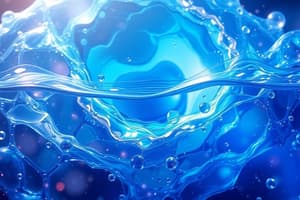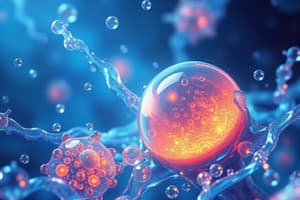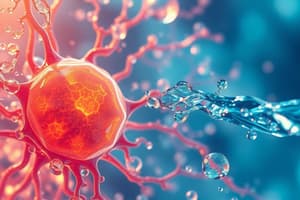Podcast
Questions and Answers
What is the main reason that Earth is considered habitable?
What is the main reason that Earth is considered habitable?
- The abundance of liquid water (correct)
- The Earth's atmosphere
- The Earth's magnetic field
- The presence of a large moon
What is the primary role of water in the cells of living organism?
What is the primary role of water in the cells of living organism?
- It acts as a structural component
- It mediates chemical reactions (correct)
- It provides energy for cellular processes
- It carries genetic information
What is the significance of water's ability to expand upon freezing?
What is the significance of water's ability to expand upon freezing?
- It ensures the survival of aquatic life during cold periods (correct)
- It allows for efficient transport of nutrients
- It provides a means for organisms to move
- It helps regulate the temperature of the environment
Which of the following is NOT an emergent property of water directly related to its polarity and hydrogen bonding?
Which of the following is NOT an emergent property of water directly related to its polarity and hydrogen bonding?
What is the primary reason for the importance of carbon in living organisms?
What is the primary reason for the importance of carbon in living organisms?
Which of the following molecules is NOT considered a primary component of living matter?
Which of the following molecules is NOT considered a primary component of living matter?
Aspartic acid is an example of:
Aspartic acid is an example of:
The statement 'Cells = bag of molecules dissolved in water' signifies which key concept?
The statement 'Cells = bag of molecules dissolved in water' signifies which key concept?
Which of the following macromolecules is NOT one of the four classes essential to all cells?
Which of the following macromolecules is NOT one of the four classes essential to all cells?
What percentage of living matter is made up of carbon, hydrogen, oxygen, and nitrogen?
What percentage of living matter is made up of carbon, hydrogen, oxygen, and nitrogen?
Which of the following elements is part of the 4% of remaining essential elements in living organisms?
Which of the following elements is part of the 4% of remaining essential elements in living organisms?
Which type of bond is characterized by the sharing of electrons between atoms?
Which type of bond is characterized by the sharing of electrons between atoms?
Which property of water is demonstrated by its ability to form hydrogen bonds?
Which property of water is demonstrated by its ability to form hydrogen bonds?
Which type of ion is formed when an atom loses one or more electrons?
Which type of ion is formed when an atom loses one or more electrons?
What term describes the measure of an atom's ability to attract and hold electrons?
What term describes the measure of an atom's ability to attract and hold electrons?
What is the primary building block of proteins?
What is the primary building block of proteins?
What role do carbohydrates play in living organisms?
What role do carbohydrates play in living organisms?
Which statement correctly describes the relationship between monomers and polymers?
Which statement correctly describes the relationship between monomers and polymers?
Which function do proteins serve in biological systems?
Which function do proteins serve in biological systems?
What characterizes lipids in biological organisms?
What characterizes lipids in biological organisms?
Which of the following best illustrates the concept of stereochemistry?
Which of the following best illustrates the concept of stereochemistry?
Which of the following compounds is NOT classified as a biological macromolecule?
Which of the following compounds is NOT classified as a biological macromolecule?
How are the structures of carbon atoms typically represented in molecular diagrams?
How are the structures of carbon atoms typically represented in molecular diagrams?
Which macromolecule is primarily responsible for encoding and transmitting genetic information?
Which macromolecule is primarily responsible for encoding and transmitting genetic information?
What type of bond links monosaccharides in disaccharides and polysaccharides?
What type of bond links monosaccharides in disaccharides and polysaccharides?
Which of the following is a storage polysaccharide in animals?
Which of the following is a storage polysaccharide in animals?
In plant cells, where is starch primarily stored?
In plant cells, where is starch primarily stored?
Which type of glycosidic linkage is commonly associated with sugars found in milk?
Which type of glycosidic linkage is commonly associated with sugars found in milk?
What is the main structural polysaccharide in fungi?
What is the main structural polysaccharide in fungi?
Which of the following is true regarding amylopectin?
Which of the following is true regarding amylopectin?
Which of the following best describes the structure of disaccharides?
Which of the following best describes the structure of disaccharides?
What defines an anomer in carbohydrates?
What defines an anomer in carbohydrates?
What characteristic of hydrophilic amino acids influences their location in proteins?
What characteristic of hydrophilic amino acids influences their location in proteins?
Which amino acid is known to introduce a kink in the protein structure?
Which amino acid is known to introduce a kink in the protein structure?
How are proteins structured at the primary level?
How are proteins structured at the primary level?
What type of bond links amino acids together in a protein?
What type of bond links amino acids together in a protein?
What type of interactions are mainly responsible for forming the secondary structures of proteins such as α-helices and β-pleated sheets?
What type of interactions are mainly responsible for forming the secondary structures of proteins such as α-helices and β-pleated sheets?
Which statement is true about disulfide bonds in proteins?
Which statement is true about disulfide bonds in proteins?
Why are some amino acids considered essential?
Why are some amino acids considered essential?
What primarily influences the tertiary structure of a protein?
What primarily influences the tertiary structure of a protein?
What does the term 'polarity' refer to in the context of proteins?
What does the term 'polarity' refer to in the context of proteins?
Which of the following bonds contributes to the stability of tertiary protein structures?
Which of the following bonds contributes to the stability of tertiary protein structures?
What occurs when a protein is denatured?
What occurs when a protein is denatured?
How many levels of structural organization do proteins have?
How many levels of structural organization do proteins have?
Which level of protein structure involves the interaction of multiple polypeptide subunits?
Which level of protein structure involves the interaction of multiple polypeptide subunits?
Which of the following is NOT a factor influencing the tertiary structure of proteins?
Which of the following is NOT a factor influencing the tertiary structure of proteins?
What can unfold or denature most proteins?
What can unfold or denature most proteins?
How many subunits make up hemoglobin?
How many subunits make up hemoglobin?
Flashcards
Biological macromolecules
Biological macromolecules
Large molecules essential for life, including carbohydrates, lipids, proteins, and nucleic acids.
Atoms
Atoms
Basic units of matter, consisting of protons, neutrons, and electrons.
Ionic bonds
Ionic bonds
Chemical bonds formed by the transfer of electrons between atoms, resulting in charged ions.
Covalent bonds
Covalent bonds
Signup and view all the flashcards
Cohesion
Cohesion
Signup and view all the flashcards
Polarity
Polarity
Signup and view all the flashcards
Functional groups
Functional groups
Signup and view all the flashcards
Essential elements for life
Essential elements for life
Signup and view all the flashcards
Water's role in life
Water's role in life
Signup and view all the flashcards
Emergent properties of water
Emergent properties of water
Signup and view all the flashcards
Polarity of water
Polarity of water
Signup and view all the flashcards
Expansion upon freezing
Expansion upon freezing
Signup and view all the flashcards
Cohesion and adhesion
Cohesion and adhesion
Signup and view all the flashcards
Moderation of temperature
Moderation of temperature
Signup and view all the flashcards
Carbon in life
Carbon in life
Signup and view all the flashcards
Aspartic acid
Aspartic acid
Signup and view all the flashcards
Nitrogen Atom Position
Nitrogen Atom Position
Signup and view all the flashcards
Carbon Atom Representation
Carbon Atom Representation
Signup and view all the flashcards
Types of Chemical Bonds
Types of Chemical Bonds
Signup and view all the flashcards
Carbohydrates
Carbohydrates
Signup and view all the flashcards
Lipids
Lipids
Signup and view all the flashcards
Nucleic Acids
Nucleic Acids
Signup and view all the flashcards
Polymers
Polymers
Signup and view all the flashcards
Fischer Projection
Fischer Projection
Signup and view all the flashcards
Haworth Projection
Haworth Projection
Signup and view all the flashcards
Glycosidic Bonds
Glycosidic Bonds
Signup and view all the flashcards
Disaccharides
Disaccharides
Signup and view all the flashcards
Storage Polysaccharides
Storage Polysaccharides
Signup and view all the flashcards
Starch
Starch
Signup and view all the flashcards
Cellulose
Cellulose
Signup and view all the flashcards
Monosaccharides
Monosaccharides
Signup and view all the flashcards
R groups in amino acids
R groups in amino acids
Signup and view all the flashcards
Hydrophilic amino acids
Hydrophilic amino acids
Signup and view all the flashcards
Hydrophobic amino acids
Hydrophobic amino acids
Signup and view all the flashcards
Special properties of glycine
Special properties of glycine
Signup and view all the flashcards
Proline's effect
Proline's effect
Signup and view all the flashcards
Cysteine bonding
Cysteine bonding
Signup and view all the flashcards
Peptide bonds
Peptide bonds
Signup and view all the flashcards
Protein structure levels
Protein structure levels
Signup and view all the flashcards
α-helix
α-helix
Signup and view all the flashcards
β-pleated sheet
β-pleated sheet
Signup and view all the flashcards
Tertiary structure
Tertiary structure
Signup and view all the flashcards
Hydrophilic interactions
Hydrophilic interactions
Signup and view all the flashcards
Denaturation
Denaturation
Signup and view all the flashcards
Quaternary structure
Quaternary structure
Signup and view all the flashcards
Chemical bonds in proteins
Chemical bonds in proteins
Signup and view all the flashcards
Lysozyme
Lysozyme
Signup and view all the flashcards
Study Notes
Biology 1 - Cells, Molecular Biology and Genetics (Biol 1000)
- Course offered by Dr. Michael Cardinal-Aucoin during Winter 2025 at York University
- Course code: Biol 1000
Building Blocks of Life
- Chemistry of Life is a fundamental topic
- Biological macromolecules include polymers, carbohydrates, lipids, proteins, and nucleic acids
Review Chapter 2
- Matter, elements, and atoms are building blocks
- Atoms consist of protons, neutrons, and electrons within a nucleus
- Atomic mass and number, isotopes, and valence electrons define an element's properties
- Ionic, covalent (non-polar and polar), hydrogen and Van der Waals forces are important types of chemical bonds
- Chemical reactions involve reactants, products, and reversible processes with equilibrium and specificity
- Properties of water include polarity, cohesion, adhesion, and high specific heat affecting reactions in biological processes
The Molecules of Life
- All cells are composed of four main biological macromolecules: carbohydrates, lipids, nucleic acids, and proteins.
- All have a carbon skeleton as a common component.
- The diversity of ways these molecules are put together leads to the multitude of forms and functions in living things
- Carbohydrates, lipids, proteins, and nucleic acids perform diverse functions at the cellular level
The Chemistry of Life
- About 20-25% of 92 elements are essential to life
- Carbon, hydrogen, oxygen, and nitrogen compose 96% of living matter.
- Remaining 4% includes calcium, phosphorus, potassium, sulfur, sodium, chlorine, and magnesium
Table 2.1: Elements in the Human Body
- Oxygen (O) accounts for 65.0% of body mass (including water).
- Carbon (C) amounts to 18.5%
- Hydrogen (H) comprises 9.5%
- Nitrogen (N) makes up 3.3%
- Calcium (Ca) is 1.5%
- Phosphorus (P) is 1.0% and so on (including other trace elements)
Water and Life
- Water is the biological medium on Earth where life originated.
- Most living organisms need water more than any other substance.
- Cells are primarily composed of water (70-95%).
- Water's abundance is vital for Earth's habitability
Summary
- Water's properties (e.g., expansion upon freezing, cohesion/adhesion, moderation of temperature, versatility as a solvent) are due to polarity and hydrogen bonding.
- The pH of water is tightly regulated in living systems.
The Backbone of Life
- Living organisms primarily consist of carbon-based compounds.
- Carbon's ability to form complex molecules is crucial to life's diversity, and is abundant in the cosmos.
- Proteins, DNA, carbohydrates, and other molecules forming living matter are based on compounds of carbon.
A note about formulae
- Aspartic acid is an amino acid, one of the building blocks of proteins.
- Aspartic acid has a chemical formula (C4H7NO4)
- Aspartic acid has a condensed structural formula as well as a Lewis Diagram and a Skeletal formula
Diversity of chemical functional groups constructed with carbon.
- Many different types of chemical functional groups can be attached to a carbon atom, and they define the properties of the resulting molecule.
The Molecules of Life
- Carbohydrates provide energy and structure.
- Lipids are diverse compounds and form membranes and function in many other roles.
- Nucleic acids comprise DNA and RNA that store information.
- Proteins are diverse in function and have important roles in structural support, as enzymes, transport, defence, hormones, and more.
Polymers
- Most biological macromolecules are polymers composed of repeated units (monomers).
- Proteins are chains of amino acids joined by peptide bonds.
Dehydration Synthesis
- Polymer construction involves dehydration synthesis (condensation reaction, forming a bond and releasing water).
Hydrolysis
- Polymer breakdown involves hydrolysis (adding water to break a bond).
Carbohydrates
- Simple sugars (monosaccharides) have a 1:2:1 ratio of C:H:O. They include glucose, fructose, ribose, sucrose, lactose, maltose.
- They serve as energy sources and structural components in organisms.
Polysaccharides
- Long chains of monosaccharides (e.g., starch, glycogen, cellulose, chitin).
- Starch is the main storage polysaccharide in plants, glycogen in animals, cellulose and chitin for structural support.
Lipids
- Lipids aren't polymers, but are grouped based on hydrophobic properties.
- Types include neutral fats, phospholipids, and steroids.
Neutral fats
- Store energy
- Insulate from cold
- Protect internal organs (e.g., triglycerides)
Phospholipids
- Major components of cell membranes
- Have hydrophobic tails and hydrophilic heads
Steroids
- Components of cell membranes (e.g., cholesterol)
- Components of vitamins (e.g., vitamin D)
- Components of hormones (e.g., growth, sex hormones)
Nucleic Acids
- Polymers composed of nucleotide subunits (nitrogenous base, pentose sugar, and phosphate).
- DNA and RNA are major examples, storing and transmitting genetic information, and are held together by phosphodiester bonds through dehydration synthesis.
- The chemical structure of DNA and RNA are important for their function.
- The Central Dogma demonstrates how DNA is transcribed into RNA, which is translated into protein.
Proteins
- Polymers of amino acid subunits, essential to nearly all life processes.
- Amino acids have a common structure with varying "R" groups, impacting unique characteristics.
- Essential amino acids must be obtained from diet.
- Proteins have four levels of organization: Primary (sequence), Secondary (a-helices and β-sheets), Tertiary (3D folding), and Quaternary (interactions of polypeptide subunits):
- Protein function is dependent on their structure.
Denaturation
- Tertiary structure dictates protein function.
- Chemical treatment or heat can denature protein (unfolding), causing disruption of bonds and losing functionality.
Quaternary structure
- Interaction of multiple polypeptide chains to create a larger functional protein.
- Hemoglobin is an example of a quaternary protein
Protein Form and Function
- Protein's 3D structure dictates its function(s)
Amino acid substitution
- Small changes in amino acid sequence can significantly affect protein function, as demonstrated by sickle cell anemia.
Proteins- Pathogens: Prions
- Prions are misfolded proteins that propagate by inducing normal proteins to misfold.
- Prion diseases involve accumulation of prion proteins in the infected tissues.
Summary
- Key concepts from the material presented, covering various biological macromolecules and their roles in living systems.
Studying That Suits You
Use AI to generate personalized quizzes and flashcards to suit your learning preferences.




